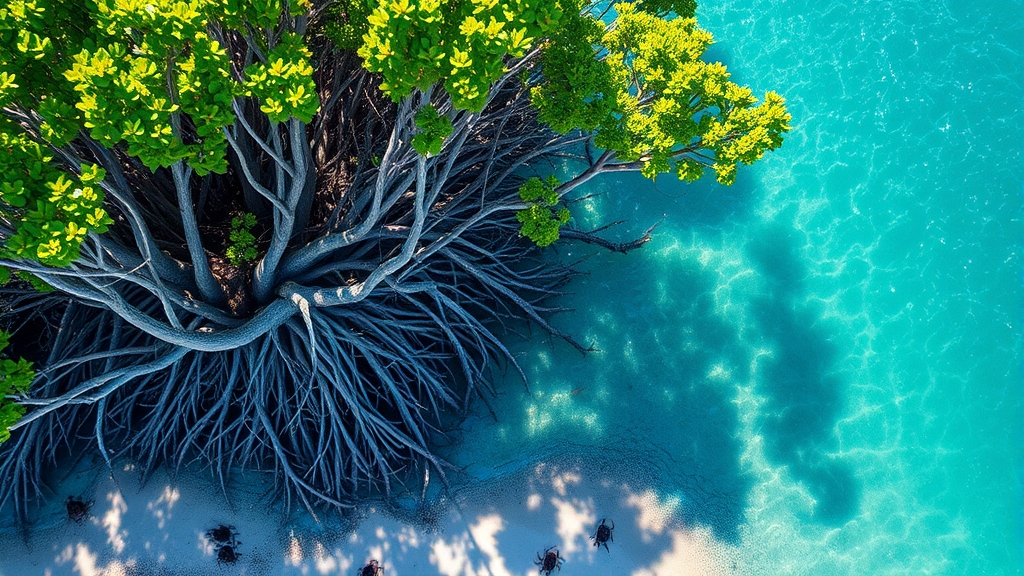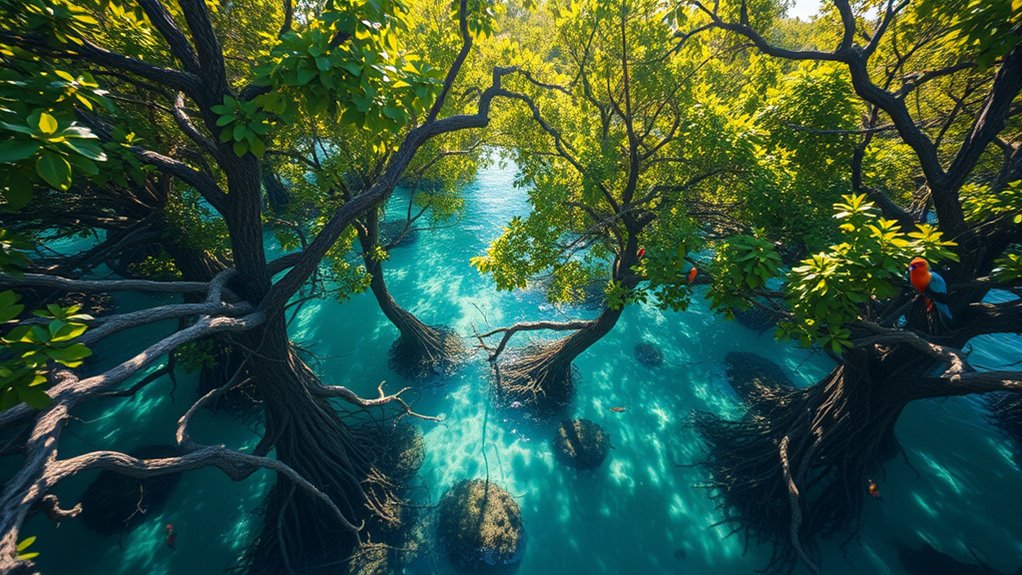Mangroves play a crucial role in protecting your coasts by reducing erosion and shielding communities from storm surges. They create essential habitats that nurture marine life, especially in their nursery grounds, helping sustain fisheries and biodiversity. By acting as natural barriers, they bolster coastal resilience against climate change impacts. Preserving and restoring these ecosystems guarantees long-term protection and healthy marine environments. If you keep exploring, you’ll discover how conservation efforts make a real difference.
Key Takeaways
- Mangroves act as natural barriers, reducing storm surge impact and preventing coastal erosion.
- They provide critical nursery habitats supporting diverse marine species.
- Conservation efforts involve community participation and sustainable restoration techniques.
- Protecting mangroves enhances coastal resilience against climate change and rising sea levels.
- Restoring mangroves supports biodiversity, ecosystem health, and local livelihoods.

Mangroves thrive at the intersection of land and sea, forming unique coastal ecosystems that support diverse plant and animal life. These essential forests act as natural barriers against storm surges, reduce coastal erosion, and provide nursery grounds for many marine species. However, despite their importance, mangroves face threats from development, pollution, and climate change. To preserve these ecosystems, restoration techniques have become indispensable. You can participate in or support initiatives that focus on replanting mangroves, removing invasive species, and restoring natural hydrology. Restoration efforts often involve planting young mangrove saplings in degraded areas, guaranteeing they have the right conditions to establish roots and grow. Techniques like hydrological restoration help re-establish water flow patterns that support mangrove health, while controlling pollution and sedimentation improves the habitat for native species. Additionally, understanding the color accuracy of projectors can help in creating visual presentations that effectively showcase the beauty and importance of mangroves.
Mangroves protect coastlines, support biodiversity, and need active restoration and community involvement for their survival.
Community involvement plays a pivotal role in mangrove conservation. When local communities understand the benefits of mangroves, they’re more likely to participate actively in preservation efforts. You can get involved by volunteering with local conservation projects, attending educational workshops, or supporting policies aimed at protecting coastal ecosystems. Community-led initiatives often include awareness campaigns that highlight the importance of mangroves for fisheries, coastal protection, and biodiversity. These efforts foster a sense of ownership and responsibility, motivating residents to reduce activities that harm mangroves, such as illegal logging or unregulated development.
Involving local communities also means integrating traditional knowledge with scientific approaches. Many coastal communities have relied on mangroves for centuries, understanding their significance and how to sustainably manage them. By empowering these communities and providing them with resources and training, you help create resilient conservation programs that are culturally appropriate and effective. Additionally, community involvement can lead to innovative solutions, like community-managed mangrove nurseries or eco-tourism initiatives, which generate income while promoting conservation.
Restoration techniques and community involvement go hand in hand to ensure the longevity of mangroves. When communities actively participate in planting, monitoring, and maintaining mangrove forests, the chances of successful restoration increase dramatically. This collaborative approach not only helps rebuild vital ecosystems but also provides economic benefits, strengthens local ties to the environment, and fosters a sense of stewardship. Protecting and restoring mangroves isn’t just about conserving trees; it’s about safeguarding coastal resilience, supporting marine life, and guaranteeing a sustainable future for the people who depend on these ecosystems.
Frequently Asked Questions
How Do Mangroves Adapt to High Salinity Levels?
You might wonder how mangroves handle high salinity levels. They adapt through salt regulation, actively filtering salt from the water they absorb. Their root adaptations, like pneumatophores and specialized structures, help them breathe and manage salt efficiently. These features allow mangroves to thrive in salty environments, ensuring they stay healthy and continue supporting coastal ecosystems despite the challenging conditions.
What Are the Main Threats Facing Mangrove Ecosystems Today?
Like a fragile tapestry, mangrove ecosystems face many threats today. Pollution impacts water quality, harming these crucial habitats, while coastal development encroaches on their space, disrupting roots and breeding grounds. Climate change brings rising sea levels and stronger storms, further jeopardizing their survival. You must recognize these dangers to help protect mangroves, as they serve as nature’s shield and nurseries for countless marine species.
Can Mangroves Help Mitigate Climate Change Effects?
Yes, mangroves can help mitigate climate change effects. You might not realize it, but they are powerful carbon sequestration systems, absorbing significant amounts of carbon dioxide from the atmosphere. They also aid in temperature regulation by reducing heat in coastal areas. Protecting and restoring mangroves allows you to leverage these natural defenses, helping to slow global warming and protect communities from climate-related impacts.
How Do Mangroves Support Local Communities Economically?
You can benefit economically from mangroves through eco-tourism benefits, as they attract visitors interested in wildlife and natural beauty. Additionally, sustainable harvesting of mangrove resources, like timber and medicinal plants, provides income without damaging the ecosystem. By supporting these practices, you help local communities thrive while preserving mangroves’ essential roles. This balance promotes long-term economic stability and environmental health, ensuring communities continue to benefit from these valuable coastal forests.
What Are the Best Practices for Mangrove Conservation?
Think of mangrove conservation as tending a delicate garden; you must nurture it carefully. To do so, you should use proven restoration techniques like planting native species and removing invasive plants. Equally important is community engagement—educate locals about mangroves’ value, involve them in restoration projects, and foster stewardship. These practices guarantee mangroves thrive, safeguarding ecosystems and supporting communities for generations to come.
Conclusion
As you appreciate the gentle embrace of mangroves, remember they quietly safeguard our shores and nurture vibrant marine life. By protecting these lush guardians, you’re helping to preserve a delicate balance that benefits everyone. Think of mangroves as nature’s soft-spoken heroes, quietly working behind the scenes. When you support their conservation, you’re ensuring that these wonderful ecosystems continue to thrive, offering beauty and bounty for generations to come.








